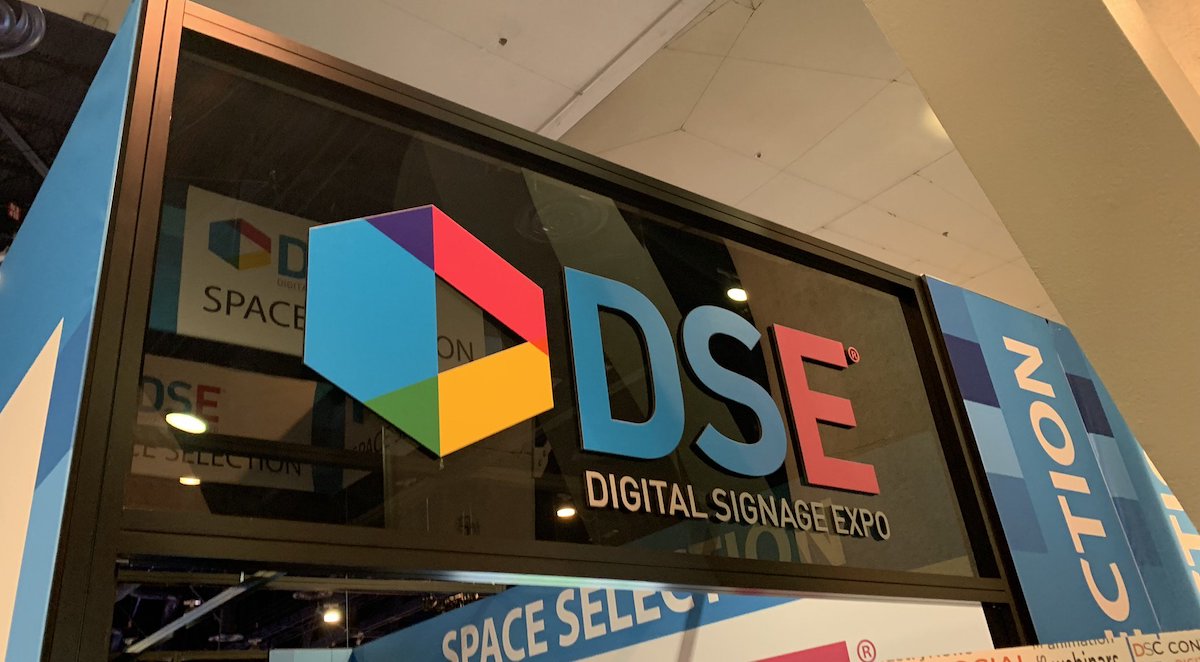
DSE 2019 Day 2 Impressions
March 29, 2019 by Dave Haynes
Sitting at the airport lounge, armed with a Bloody Mary, and thinking through Day 2 of Digital Signage Expo.
It was busier than I expected. There was not the serious day 2 swoon in traffic that I saw a year ago. I spoke with a few exhibitors who said they were happy with foot traffic because the people who walked up were serious opportunities, not just folks meandering around and asking what vendors did, or non-exhibiting vendors doing surreptitious iPad demos on the floor.
I don’t know what the DSE numbers say, but exhibitors benchmark their booth investment based on warm leads, not raw foot traffic counts. Andrea Varrone, the show’s director, appears to be running with that theme:
Numbers are in…best End User attendance in show history, and surpassed 2018 numbers! More to come…..#DSE2019 #AVtweeps ???????? pic.twitter.com/6XPncmLjVL
— Andrea Varrone (@andreavarrone) March 29, 2019
I think most observers would say the overall foot traffic count was down, but again, if you spend big dollars to do a booth and fly, sleep, feed and entertain staffers, you are more interested in the buyer-potential quality of booth visitors, not the quantity.
However, overall traffic has been and is part of the story, as is the exhibitor count and floor footprint. When I checked last Friday, the exhibitor count was 190, which would be down by about 5% from last year. It usually takes a week or so before the show crafts an announcement on how things went down.
I invested way more time poking around and talking to people on Thursday. While I’d stop well short of saying I saw things that blew my mind or were genuinely new and unseen, I saw lots of good and interesting stuff.
Lightning impressions:
It was weird not seeing LG there with a booth. They opted out of the show, unless you want to count a temporary meeting room way, way at the back. LG-MRI had a BIG impressive booth at the front, but that’s a joint venture run out of Atlanta, and not in any real way LG.
Philips also just did the meeting room at the back thing. Intel did not have a space, at all, though there were numerous people in from Phoenix. The company did an event somewhere on Wednesday – NOT that I was invited! ;-]
I now get how X20 fits in the Stratacache family. Had a demo of how the software, picked up in a fire sale from Barco, complements the other elements in the solution stack Chris Riegel is steadily building. It’s about communicating in workplaces, and visualizing data.
Riegel has been doing trade shows, and paying for all that, for most of the last 12 weeks, so he was happy there is now a lull in shows. Dunno if a Stratacache family company is at InfoComm.
Jeff Hastings, CEO of BrightSign, walked me through BSN.cloud, a relatively new service that makes it easy for software companies to fully work with its range of little purple media players. I had heard suggestions the service was developing into a CMS competitor for the many software companies that have been developing their platform to run on BrightSign boxes. But Hastings says BSN.cloud is a mechanism that makes it way easier for software companies to make their platforms work on his boxes, and then manage them.
If an integrator or end-user wants a specific CMS to run on BrightSign boxes and the software firm didn’t already do that, it was a big job to create that compatibility. Faced with the time and cost, some would just say No. With BSN.cloud, that integration can happen quickly and give the platforms things like deep device management.
Hastings says he is shipping large piles of his company’s embedded player modules, which are a different take on system on chip displays. These can be popped in and pulled out as needed, whereas smart display SOC’s can’t typically be removed or switched out. Much of what is shipping is going into smaller form factor screens for Mimo and Bluefin, and being used for things like meeting room signs and shelf-edge displays.
Speaking of BrightSign, this is hysterical:
No! That is not swag!!! #DSE2019 a dude tried to walk off with some @BrightSign players. He actually said with a straight face, “I thought it was a give away!” ???? pic.twitter.com/zBKjwuPkM2
— Kaleoiini (@Kaleoiini) March 29, 2019
The BrightSign cloud thing is a bit like what SignageOS is doing, but instead of making software work on specific boxes, the Czech firm is making it possible for CMS software companies to get their platforms working quickly on multiple hardware/OS platforms like LG webOS and Samsung’s Tizen. I had a good chat with the guys, who have added deep device management and are angling towards creating what they refer to as a digital signage OS.
They also brought me Czech booze, again! They know how to co-opt me :-]
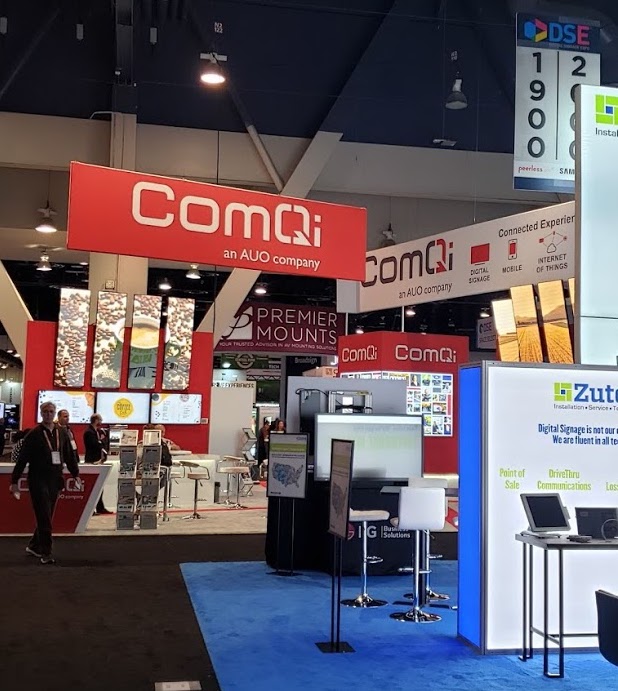
ComQi, now owned by Taiwan’s AUO, had a far bigger booth than ever. Stu Armstrong, the figurehead for the company since 1603, said the booth was large enough to be seen from space. Which is weird, because the LVCC has a roof. It was indeed big and impressive.
The company has a lot of nice retail-centric functionality, like dead-simple store take-over triggers that push the same message, at once, on every screen in a store. The AUO tie-in is obvious with all the screen options it brings, as Taiwan is a massive panel and display components manufacturer.
I spent some quality time in Elo’s big booth, and was impressed by what they’re up to. Touch displays are the thing around Elo, but the company’s “smart screens” are being bought, in some cases, because of the computing horsepower and capabilities.
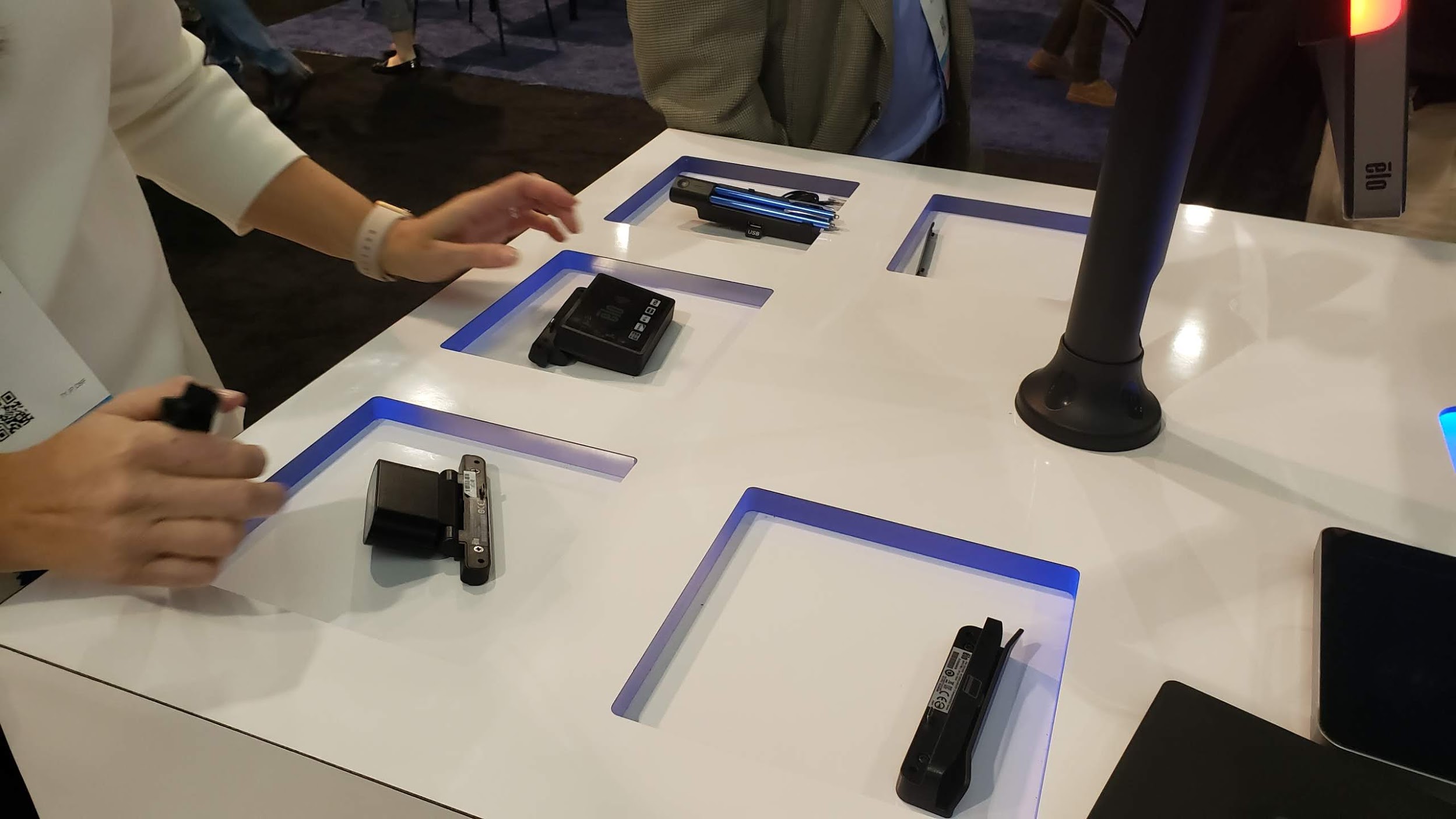
I liked how they had small displays that had snap on module ports, so things like meeting room status lights, card readers or other sensors could be added as peripheral pieces – without having to have several manufactured versions of the displays that have those different things.
Elo has its own software, EloView, which provides a ton of device management and makes it easy to do things like push in new Android applications – jobs that might otherwise intimidate the hell out of an integrator. Elo is a touch company, but some end-users are buying their big touch screens and not using the touch part of it, because the smart displays run Android 7.1, which is well ahead of what some other Android SOC screens support.
I had a walk-through of Samsung’s booth. I’ve seen them at multiple shows in 2019, but there was way less exhibit floor crowd chaos at DSE, and therefore more time to see things and ask questions. The 8K QLED screens that are coming this year are OhMyGod stunning, and an interesting wrinkle is how AI is being used to optimize visuals. So if a full HD video was running, and the media scaled up to meet the bigger resolution, AI looks at each pixel and can color-match any gaps. Or something like that …
Samsung also has a retail intelligence/video analytics platform called NexShop. It looked fairly embryonic, particularly when compared to what NEC is rolling out with ALP.
Rich Ventura of NEC has been showing and updating me on it for the last 18 months, and it is now really, really deep and powerful. Aimed at retail, it uses sensors, real-time integrated data and a lot of back-end work to give anyone from a store’s head office marketing wing to CFOs and CIOs a sense of what’s happening in stores.
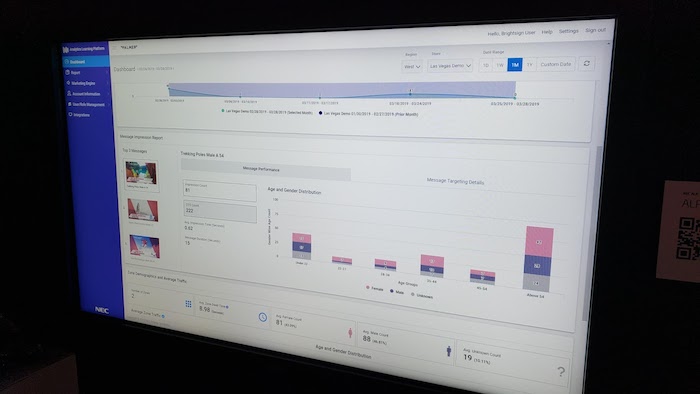
Example: it can report how many people had an opportunity to see a message, how many did, for how, and how many were converted to buyers of that promoted product. It is an open system, and several companies – like BrightSign and SignageLive – are integrating with ALP.
NEC was also showing a tie-in that uses its laser projectors to drive visuals on switchable glass windows. The office products guys, Avery Dennison, have switchable film that can be clear, or translucent on command to support showing projection. They had a nice demo for a shop window, built around The Hangover.
The projection on glass thing, which was a big idea 15 years ago, seems to be coming back because of lower costs and much longer operating lives of projectors (lasers instead of bulbs). Short throw lenses also help, as the set-ups consume less leased space in a store.
I liked what a company called Nummax, from Montreal, is doing in direct view LED. They design in Canada and contract-manufacture in China. What caught my eye were LED window displays that are in poster form factors, so they can hang in windows, and have the media player and other bits built-in. They look better than the mesh screen window screens I have seen, and are waaaay less costly than sunlight-viewable LCDs designed for windows.
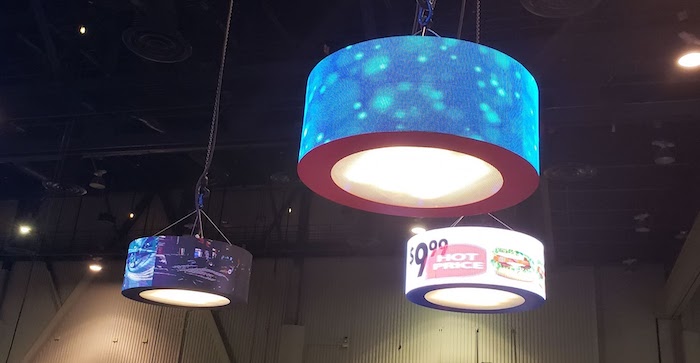
Nummax was also getting a lot of interest, accidentally, in suspended light fixtures that had a ring of LEDs around them. CEO Michel Hunault said the lights were designed as booth eye candy, but people who work in sectors like restaurants were looking to buy.
I spoke with yet more companies coming in as CMS software plays. Wallboard, which is partly Texas, partly Hungary, had an active booth but at least what I heard and saw was pretty much the same as dozens of others. I liked what I saw of ScreenCloud, which comes out of London.
Back in the innovation area I saw a company called YantraNet that comes out of IOT device management but is now also offering a signage solution. What was interesting to me was the company – part Indian, part American – is spinning up a white-labeled service that is CMS, media player, device management and unlimited content for about a $1 a day per device. So instead of buying feeds from a third party provider, this is all feeds – as many as you want in finished formats – included.
I also spoke back there with Kitcast – which is half US, half Ukraine. It is doing well with a CMS platform all focused on using Apple TV boxes as media players. Most consumer devices are dodgy, at best, for commercial uses, but an Apple TV is very different from a cheap Android set-top box.
Carousel, the digital signage side of Tightrope Media Systems, is also using Apple TVs and moving a lot of them, particularly in education. They had a great-looking booth – I think the same as used last year and at InfoComm.
Great to see piles of industry friends – some who I only see once or twice a year at these things. Flying home today and hoping Westjet is not the ongoing cluster**** it has been in recent trips.
One good thing about DSE – no time for news or TV, so I was pretty much Trump-free for five days. Except for seeing that hotel. Nice while it lasted, but can see on Twitter the loopiness continues.
Next show for me is the SID Display Week event in Silicon Valley in May. It is a nerdgasm and I won’t understand a lot of what the engineers are going on about, but I will ask questions and try to simplify explanations and attributes for emerging stuff like like mini LED and light field displays.
DSE is scheduled next year for April 1-2. Same hall.
Back to normal writing next week. I need to post on the Apex Awards, which were, ummm, curious. Safe travels home if you are still in LV.



Leave a comment